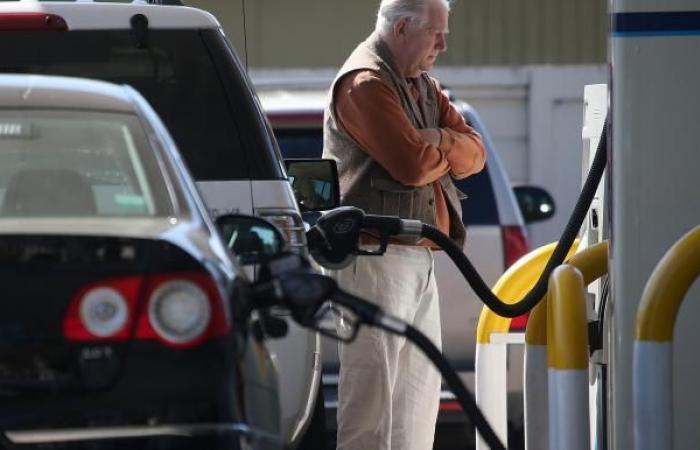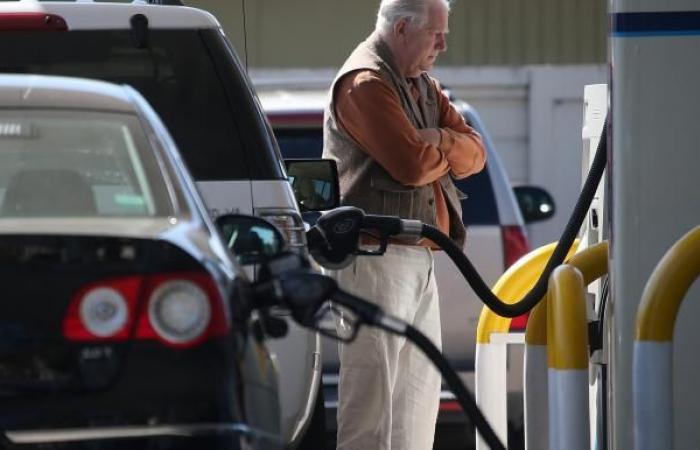A gas station in California (Getty)seem oil producers They are more precautionary in dealing with global markets, as the blow they have suffered with the collapse of prices in recent years has not been easy, which is what prompts them to hold on to matters this time with the rise of crude prices Again, ignoring pressure from Washington and major consumers.
The policy of “OPEC” and its allies among the major producers, led by Russia, is calm in dealing with the angry reaction of consumers over the surge in prices.
However, analysts believe that the alliance of producers’ adherence to supply control is a response to the kick they were subjected to before, due to the oversupply caused by US shale oil, and Washington’s pressure during the administration of former US President Donald Trump to reduce prices, as well as the repercussions of the new Corona virus pandemic that swept away Prices for the abyss last year.
Oil prices have jumped since the beginning of this year by more than 70%, which supplies the coffers of producers, especially the Gulf countries, whose foreign reserves expected, two days ago, to rise between 300 and 350 billion dollars over the next three years, taking advantage of the significant rise in prices.
Bank of America expects the price of oil to rise to $120 a barrel by the end of June next year
It does not seem that the Gulf states may easily abandon these gains, after their finances over the past years suffered from financial deficits and were forced to borrow from international markets, while floating on vast wealth of oil and gas.
Despite the emergence of anti-fossil fuel alliances with the aim of reducing it, this goal may not be close to reach, given the huge assets that move in the oil and gas orbit, in addition to the fact that the Gulf states are still far from diversifying sources of income, which makes them more adherent to their underground wealth.
Brent crude prices continued their upward journey in futures contracts, above $85 a barrel, and West Texas Intermediate crude exceeded $84 a barrel, yesterday, Wednesday, after data revealed that US crude stocks fell unexpectedly last week, with travel demand starting to recover. easing pandemic restrictions.
The two crudes touched their highest levels in two weeks, as data from the American Petroleum Institute revealed that crude stocks in the United States decreased by 2.5 million barrels, in the week ending on the fifth of November, which far exceeds analyst expectations.
Global demand has recovered to pre-pandemic levels for 2019 and is expected to rise further in early 2022, said Russell Hardy, president of Vitol Group, the world’s largest independent oil trader.
Hardy added, during his online participation in the “Reuters Commodity Trade” conference, according to what was reported by the American Bloomberg Agency, on Tuesday evening, that the supply and demand in the market “will be severe” during the next 12 months, and that the rise in prices to $ 100 a barrel is “an order”. Certainly possible.”
He added that the oil market will remain tight, as OPEC producers currently have between two and three million barrels per day of spare production capacity, while the growth of US oil production will be less than one million barrels of oil per day in 2022, which indicates that the balance between Supply and demand will remain tight.
And the American investment bank, “JP Morgan Chase” and British Petroleum, said earlier this November that global demand for oil has almost returned to its pre-pandemic levels at the level of 100 million barrels per day.
While many investment banks expected the price of oil to reach $100 a barrel next year, Bank of America saw that prices might break these levels to reach $120 a barrel by the end of June of next year.
The recovery in oil demand and the continued rise in prices came as calls emerged for the formation of a coalition against fossil fuels, as well as the discussion of world leaders at the Glasgow conference to combat climate change by relying on green alternatives to energy.
But Damian Corvalin, an oil analyst at Goldman Sachs, the US, said in a note that “winter demand and the recovery in international demand for jet fuel mean consumption will reach record levels early next year.”
After more than a year of reduced demand for fuel, consumption of gasoline and other oil derivatives is back on the rise in the United States, the world’s largest consumer of fuel, as well as in various major economies.
Crude prices were also supported by concerns about coal and gas shortages in China, India and Europe, prompting a shift to diesel and fuel oil for power generation.
Prices are also boosted by supply restrictions from the Organization of the Petroleum Exporting Countries and its allies, the group known as “OPEC +”. The alliance agreed, last week, to stick to its plan to gradually increase production.
Currently, the “OPEC +” alliance is raising daily production by 400,000 barrels, and resisting pressure from global markets to produce more, as it was agreed on this increase last July, to continue every month until at least April 2022, to gradually get rid of the cuts. It amounts to 5.8 million barrels per day.
The rising prices have become a challenge to US President Joe Biden, who is seeking in every way to pressure OPEC to increase supplies, as Bloomberg Agency quoted a senior US official as saying, on the sidelines of the G20 summit in Rome at the end of last month, that the United States is talking with other countries. Oil-consuming countries on how to put pressure on the “OPEC +” alliance of 23 countries.
The International Monetary Fund expects the foreign reserves of the Gulf countries to rise between 300 and 350 billion dollars over the next three years
And at the beginning of this week, US Energy Secretary Jennifer Granholm revealed that the Biden administration is considering using the strategic oil reserve as a means that can help reduce prices, adding that “the president does not want to see the price of fuel harm real people,” and that high fuel prices, such as Those seen in Europe, are not accepted in the United States. She added that some poor people spend up to 30% of their monthly income on fuel.
But resorting to the strategic reserve involves risks, despite it mitigating the price shock, as the reserve currently stands at about 612 million barrels, and it aims primarily to mitigate the impact of economic disasters that may be caused by events such as hurricanes or other natural disasters.
So oil market players have warned that a potential resort to strategic reserves may have little effect, even as the Biden administration has floated the idea as a way to influence prices.
After accounting for mandatory sales approved by Congress in advance, and the minimum required at storage sites, the Biden administration will likely have the ability to use a maximum of 60 million barrels, according to a source at one of the world’s largest oil trading companies, who requested anonymity. According to a Bloomberg report, earlier this week. This is equivalent to just over three days of average consumption in the US, given 2020 levels.
Rising oil prices also threaten Biden’s plans to halt oil imports from Canada due to environmental safety. On Monday, the White House announced that it was awaiting a study by the US Army Corps of Engineers before deciding to discuss the future of the controversial oil pipeline that will transport Canadian oil across the Great Lakes to Michigan.
Speculation that Biden was considering closing that line, as he recently did with TC Energy Corp’s Keystone XL project, has sparked angry reactions among Republicans, at a time when the country is grappling with soaring prices for everything from Cooking gas to gasoline.
Therefore, analysts are likely to intensify pressures on OPEC and its allies to pump more supplies to calm prices, but the response to the pressures has exposed the alliance to crack, while it faced great difficulties in order to unite its ranks during the past months to put an end to the collapse of prices, which came in the interest of major consumers globally.
The escalating oil prices are bringing the Gulf countries out of the deflationary cycle that they recorded last year, as the World Bank expected, last August, that the economies of the Gulf countries would grow by 2.2% this year, after a 4.8% contraction in 2020.
Data issued by the Gulf Statistics Center last August also showed that the reserve assets of the Gulf countries rose to 664.9 billion dollars at the end of last June, compared to 656.7 billion dollars in May.
Despite the increase in the value of reserve assets, they are much lower than their levels at the end of 2019, when they amounted to about $707.8 billion.
Oil prices have jumped since the beginning of this year by more than 70%, which provides the coffers of producers with gains, especially the Gulf countries.
In October, the Institute of International Finance expected that the Gulf countries would witness current account surpluses of $165 billion this year, and $138 billion next year, after a deficit of six billion last year. Meanwhile, analysts believe that the surpluses will exceed the expectations of the institute, as it was based on an oil price of $71 a barrel this year, and $66 a barrel next year.
Nor is it expected that US and European pressure towards increasing clean energy sources will bear fruit in the near term. Banking data show that global banks have provided facilities for financing fossil fuels since the Paris climate agreement in 2015 with nearly 4 trillion dollars, and received revenues and fees from these operations equivalent to 17 billion dollars, according to data compiled by Bloomberg, while in return they provided about 1.5 trillion dollars in financing. dollars for green investments during the same period.
These were the details of the news Oil prices fuel consumers’ anger… and OPEC clings to its gains for this day. We hope that we have succeeded by giving you the full details and information. To follow all our news, you can subscribe to the alerts system or to one of our different systems to provide you with all that is new.
It is also worth noting that the original news has been published and is available at saudi24news and the editorial team at AlKhaleej Today has confirmed it and it has been modified, and it may have been completely transferred or quoted from it and you can read and follow this news from its main source.






